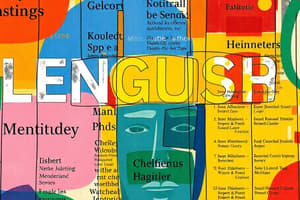Podcast
Questions and Answers
From which language family did English originate?
From which language family did English originate?
- Indo-Iranian
- West Germanic (correct)
- Romance
- Slavic
English uses a subject-verb-object sentence structure.
English uses a subject-verb-object sentence structure.
True (A)
Words that represent people, places, things, or ideas are called __________.
Words that represent people, places, things, or ideas are called __________.
nouns
Which of the following authors is associated with Early Modern English?
Which of the following authors is associated with Early Modern English?
Which verb tense describes habitual actions or general truths?
Which verb tense describes habitual actions or general truths?
Proper nouns refer to general classes of items.
Proper nouns refer to general classes of items.
What is the function of an adjective?
What is the function of an adjective?
Match the following verb tenses with their descriptions:
Match the following verb tenses with their descriptions:
Which part of speech modifies a verb, adjective, or another adverb?
Which part of speech modifies a verb, adjective, or another adverb?
A simple sentence contains two or more independent clauses.
A simple sentence contains two or more independent clauses.
What punctuation mark is used to enclose direct quotations?
What punctuation mark is used to enclose direct quotations?
A comparison using 'like' or 'as' is known as a(n) ______.
A comparison using 'like' or 'as' is known as a(n) ______.
Match the writing style with its description:
Match the writing style with its description:
What is the basic part of a word that carries the primary meaning?
What is the basic part of a word that carries the primary meaning?
Cockney is a dialect traditionally spoken by working-class New Yorkers.
Cockney is a dialect traditionally spoken by working-class New Yorkers.
What is a word that connects words, phrases, or clauses?
What is a word that connects words, phrases, or clauses?
Giving human qualities to non-human things is known as ______.
Giving human qualities to non-human things is known as ______.
Which sentence uses the future continuous tense?
Which sentence uses the future continuous tense?
Flashcards
What is English?
What is English?
A West Germanic language originating from Anglo-Saxon dialects brought to Britain.
What is Old English?
What is Old English?
A period of English from approximately 450-1150 AD, influenced by Germanic languages.
What is Middle English?
What is Middle English?
A period of English from approximately 1150-1500 AD, influenced by the Norman Conquest and French.
What is Early Modern English?
What is Early Modern English?
Signup and view all the flashcards
What are nouns?
What are nouns?
Signup and view all the flashcards
What are pronouns?
What are pronouns?
Signup and view all the flashcards
What are verbs?
What are verbs?
Signup and view all the flashcards
What is Present Continuous?
What is Present Continuous?
Signup and view all the flashcards
Future Continuous
Future Continuous
Signup and view all the flashcards
Nouns
Nouns
Signup and view all the flashcards
Verbs
Verbs
Signup and view all the flashcards
Conjunctions
Conjunctions
Signup and view all the flashcards
Compound Sentence
Compound Sentence
Signup and view all the flashcards
Simile
Simile
Signup and view all the flashcards
Personification
Personification
Signup and view all the flashcards
Alliteration
Alliteration
Signup and view all the flashcards
Context Clues
Context Clues
Signup and view all the flashcards
Dialect
Dialect
Signup and view all the flashcards
Study Notes
- English is a West Germanic language that originated from Anglo-Saxon dialects brought to Britain by Germanic settlers.
- English has become the dominant international language of business, education, and communication.
- English has a large vocabulary, incorporating words from many other languages, including Latin, Greek, and French.
History of the English Language
- Old English (c. 450-1150 AD) was influenced by Germanic languages.
- Notable texts include "Beowulf".
- Middle English (c. 1150-1500 AD) was influenced by the Norman Conquest and French.
- Notable authors include Geoffrey Chaucer ("The Canterbury Tales").
- Early Modern English (c. 1500-1800 AD) saw the Great Vowel Shift and the Renaissance.
- Notable authors include William Shakespeare.
- Modern English (c. 1800-present) has seen standardization and global spread.
Grammar Basics
- English uses a subject-verb-object (SVO) sentence structure.
- Nouns are words that represent people, places, things, or ideas.
- Common nouns refer to general items, like "dog" or "city."
- Proper nouns refer to specific items and are capitalized, like "Fido" or "London."
- Pronouns replace nouns, such as "he," "she," "it," "they."
- Verbs express actions, occurrences, or states of being.
- Main verbs carry the primary meaning, like "run" or "think."
- Auxiliary verbs (helping verbs) assist the main verb, such as "is," "are," "was," "were," "have," "do."
- Adjectives describe nouns, such as "red," "tall," "interesting."
- Adverbs modify verbs, adjectives, or other adverbs, such as "quickly," "very," "well."
- Prepositions show relationships between words, such as "in," "on," "at," "to," "from."
- Conjunctions connect words, phrases, or clauses, such as "and," "but," "or," "because."
- Articles specify nouns, such as "a," "an," "the."
Verb Tenses
- Simple Present: Describes habitual actions or general truths (e.g., "I eat breakfast").
- Present Continuous: Describes actions happening now or around now (e.g., "I am eating breakfast").
- Simple Past: Describes completed actions in the past (e.g., "I ate breakfast").
- Past Continuous: Describes actions in progress in the past (e.g., "I was eating breakfast").
- Present Perfect: Describes actions that started in the past and continue to the present or have a result in the present (e.g., "I have eaten breakfast").
- Past Perfect: Describes actions completed before another action in the past (e.g., "I had eaten breakfast before I left").
- Simple Future: Describes actions that will happen in the future (e.g., "I will eat breakfast").
- Future Continuous: Describes actions that will be in progress at a specific time in the future (e.g., "I will be eating breakfast at 8 am").
Parts of Speech
- Nouns: Words that represent persons, places, things, or ideas.
- Pronouns: Words that replace nouns.
- Verbs: Words that express actions, occurrences, or states of being.
- Adjectives: Words that describe nouns.
- Adverbs: Words that modify verbs, adjectives, or other adverbs.
- Prepositions: show the relationship between a noun or pronoun and other words in the sentence.
- Conjunctions: Words that connect words, phrases, or clauses.
- Interjections: Words that express strong emotion.
Sentence Structure
- Simple Sentence: Contains one independent clause (e.g., "The dog barked").
- Compound Sentence: Contains two or more independent clauses joined by a coordinating conjunction (e.g., "The dog barked, and the cat meowed").
- Complex Sentence: Contains one independent clause and one or more dependent clauses (e.g., "Because it was raining, I took my umbrella").
- Compound-Complex Sentence: Contains two or more independent clauses and one or more dependent clauses (e.g., "Because it was raining, I took my umbrella, and I wore a coat").
Punctuation
- Period (.): Marks the end of a declarative sentence.
- Question Mark (?): Marks the end of an interrogative sentence.
- Exclamation Point (!): Marks the end of an exclamatory sentence.
- Comma (,): Separates elements in a series, sets off introductory phrases, and separates clauses in certain compound sentences.
- Semicolon (;): Connects two independent clauses that are closely related.
- Colon (:): Introduces a list, explanation, or example.
- Apostrophe ('): Indicates possession or contraction.
- Quotation Marks (" "): Enclose direct quotations.
Figures of Speech
- Simile: A comparison using "like" or "as" (e.g., "He is as brave as a lion").
- Metaphor: A direct comparison without using "like" or "as" (e.g., "He is a lion").
- Personification: Giving human qualities to non-human things (e.g., "The wind whispered secrets").
- Hyperbole: An exaggeration (e.g., "I'm so hungry I could eat a horse").
- Understatement: A statement that is intentionally weakened to create an effect (e.g., "It's just a scratch" when there's a large wound).
- Irony: A contrast between what is said and what is actually meant (verbal), what occurs and what is expected (situational), or what the audience knows and what a character knows (dramatic).
- Alliteration: Repetition of initial consonant sounds (e.g., "Peter Piper picked a peck of pickled peppers").
- Onomatopoeia: Words that imitate sounds (e.g., "buzz," "hiss," "bang").
Literary Devices
- Allusion: An indirect reference to a well-known person, place, event, literary work, or work of art
- Analogy: A comparison between two things, typically for the purpose of explanation or clarification
- Antithesis: The juxtaposition of contrasting ideas in parallel structure
- Foreshadowing: A warning or indication of a future event
- Imagery: Visually descriptive or figurative language, especially in a literary work
- Symbolism: The use of symbols to represent ideas or qualities
- Theme: The central topic or idea explored in a text
Writing Styles
- Narrative: Tells a story.
- Descriptive: Provides detailed descriptions.
- Expository: Explains a topic.
- Persuasive: Argues a point of view.
Vocabulary Building
- Root Words: The basic part of a word that carries the primary meaning.
- Prefixes: Added to the beginning of a word to change its meaning.
- Suffixes: Added to the end of a word to change its meaning.
- Context Clues: Using the surrounding words to understand the meaning of an unfamiliar word.
Dialects
- A dialect is a regional or social variety of a language distinguished by pronunciation, grammar, and vocabulary.
- Examples include:
- Received Pronunciation (RP): Often considered the "standard" British accent.
- Cockney: A dialect traditionally spoken by working-class Londoners.
- African American Vernacular English (AAVE): A dialect spoken by many African Americans.
English as a Global Language
- English is an official language in many countries.
- It's widely used in international business, diplomacy, and science.
- The internet has further contributed to its global prevalence.
Studying That Suits You
Use AI to generate personalized quizzes and flashcards to suit your learning preferences.




